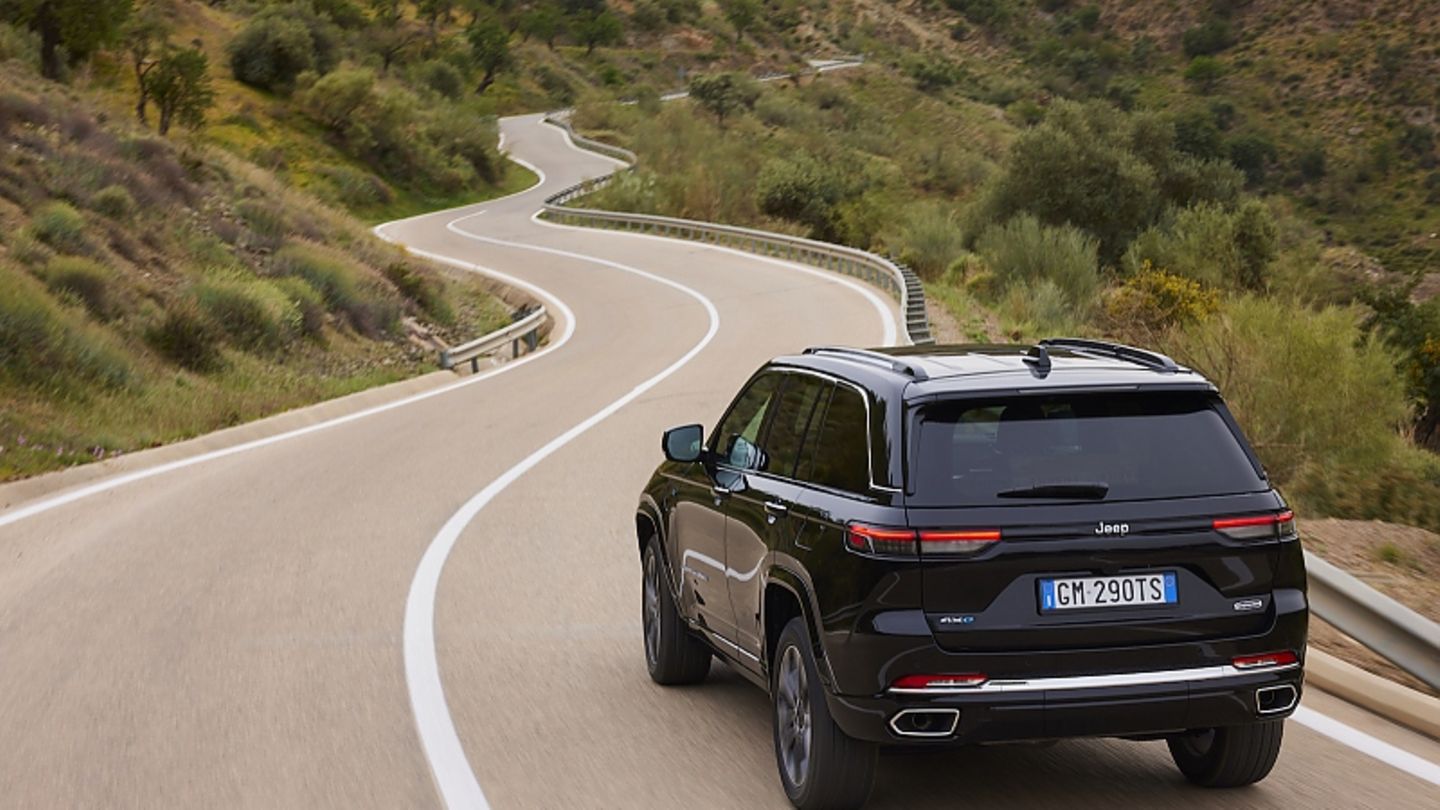Jeep also wants to become electric step by step in the coming years. In the transition period to electromobility, Stellantis is focusing on plug-in hybrids for large off-road vehicles, especially in Europe, which are intended to reconcile the advantages of combustion engines and electric motors. While the Grand Cherokee is also available with six and eight cylinders in the USA, only the plug-in hybrid variant is offered here.
A four-cylinder in an imposing luxury SUV like the Jeep Grand Cherokee – that comes as a shock to many fans. Brands such as Mercedes, BMW, Volvo and Range Rover have also tried the hybrid cylinder square – some, however, have rowed back to six or eight cylinders, because in addition to the drive power, the image also plays an important role in this league. The current Jeep Grand Cherokee is positioned significantly higher than its predecessors, more elegant than ever and therefore no longer has to hide from the competition from Audi, BMW, Mercedes, Cadillac or Range Rover. For the first time there are equipment details such as air-conditioned massage seats, four-zone automatic climate control, 950-watt audio system with 19 speakers, countless power connections and an entertainment system for rear passengers. The different trim levels differ more than one would expect: some use real wood on the dashboard and door panels, others use imitation wood on exactly the same surfaces, which is hardly acceptable for a vehicle with a starting price of 79,500 euros .
The layout and contents of the dashboard have evolved significantly compared to the previous model. There is a triumvirate of a 10.25-inch instrument panel, a central 10.1-inch infotainment display and a 10.25-inch screen on which the front passenger can watch films or other content, which can be viewed via an HDMI socket can connect devices. In addition, the Grand Cherokee offers a 10-inch head-up display – more visualization is not possible. There is little space in the center console, as the gear lever has been replaced by a rotary wheel, next to which is the button for the reduction and the selector for the driving mode (rock / sand-mud / snow / auto / sport), with which the response of the Engine, transmission and all-wheel drive system is changed. In addition, the ground clearance can also be set variably in five stages. All Grand Cherokees except the entry-level version are equipped with air suspension that allows a maximum ground clearance of 27.5 centimeters.
The interior space is generous for up to five adult occupants: 152 cm of shoulder room in the front and 147 cm in the second row, which corresponds to that of a Mercedes GLE, are more than in a Lexus RX. The legroom in the rear is 75 cm, slightly less than in the Mercedes GLE or the VW Touareg. But since the headroom is ample, long-legged rear passengers can settle into a more upright position. In the rear there are direct air vents with temperature and flow control. The trunk has a capacity of 533 liters, which can be increased significantly by folding the rear seats.
The drive system combines something unusual for such a luxury colossus, a two-liter four-cylinder turbo petrol engine (200 kW / 272 hp) with two electric motors, of which the more powerful with 100 kW / 136 hp is integrated into the eight-speed automatic transmission and a second motor with 33 kW / 45 hp that replaces the starter and alternator. Coupled to the crankshaft of the petrol engine, it serves to recover energy when braking and provides a small boost when accelerating. The powertrain with its maximum output of 380 hp and 637 Nm of torque is equipped with two clutches and a 17.3 kWh battery pack. In pure electric mode, the Grand Cherokee can cover less than 50 kilometers and reach a top speed of 120 km/h.
On the Autobahn, it quickly becomes clear that 281 kW / 380 PS / 637 Nm is easily enough for brisk driving performance and the electric boost can be felt at low engine speeds. But when the combustion engine kicks in, performance queries quickly become loud and strained, because the four cylinders have a hard time moving the 2.5-ton all-wheel drive colossus cheerfully. Even double glazing and insulating materials cannot cover this up. At constant speed, the all-wheel drive system decouples the front axle and the Grand Cherokee is driven via the rear wheels to improve efficiency. Otherwise, the power distribution regulates itself variably according to the corresponding driving mode. Somewhat surprisingly, the plug-in hybrid is predominantly in combustion mode, which is also reflected in the high average consumption of 12.7 liters per 100 kilometers. One reason is the high weight in connection with the comparatively small battery pack. Some competitors travel 100 kilometers purely electrically.
In normal driving, the Grand Cherokee is extremely comfortable and pushes bumps away easily thanks to the variable air suspension. The steering is deliberately smooth and quite synthetic – not unusual for the vehicle class and the main market USA. In Sport mode, on the other hand, the package is a little better. Unlike most of its premium competitors, every Jeep Grand Cherokee still has hardcore off-road driving in its genes. When the terrain gets rough, you can rely almost blindly on low gear, dual differential locks, a switchable front anti-roll bar and off-road cruise control. After engaging low gear and selecting the speed, there is no need to press the accelerator or brake pedals, the speed is maintained and can be adjusted from 1 to 8 km/h using the steering wheel paddles. However, only the particularly off-road Trailhawk version, which also offers 75 millimeters more ground clearance, offers a detachable stabilizer and off-road cruise control, while the other versions are limited to 60 millimeters.
Like the top-of-the-range Summit Reserve, the Trailhawk features the most advanced transmission system available, called Quadra Drive II, which features an electronically controlled limited-slip differential on the rear axle to compensate for differences in traction between the individual rear wheels. With the less sophisticated Quadra Trac II system, the brakes decelerate the wheels, which would otherwise spin in the absence of traction. Especially when driving off-road, the digital cameras help to project images of what is under, behind or around the vehicle. The fact that many of the systems activate and deactivate themselves makes life much easier for the driver in off-road use, especially for part-time climbers.
Source: Stern
I’m a recent graduate of the University of Missouri with a degree in journalism. I started working as a news reporter for 24 Hours World about two years ago, and I’ve been writing articles ever since. My main focus is automotive news, but I’ve also written about politics, lifestyle, and entertainment.




